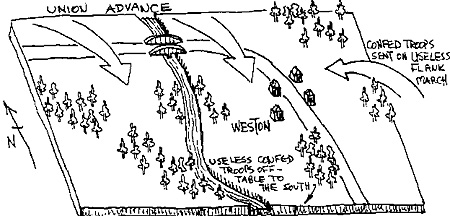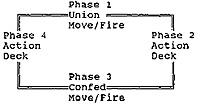 Our American Civil War campaign seems to have gotten started. The Union was bashed in the first battle, while we Confederates took it on the chin in the second.
Our American Civil War campaign seems to have gotten started. The Union was bashed in the first battle, while we Confederates took it on the chin in the second.
There are 7 Union forces, all starting well to the north, off the campaign field. Opposing them are 5 Confederate field forces, essentially playing defensively. The Union's troops must march south, eventually exiting the map on the southern baseline, and on their way, capture towns and destroy Southern depots. The Rebels objective is simply to stop the Union advance.
30mm ACW troops are used to fight the battles, and the scale is based on a 4-stand regiment. A brigade consists of, perhaps, 2 or 3 regiments, and a division is composed of 3 brigades. This means that with the 30mm troops on the table, the average size force consists of around 50 infantry stands, plus supporting cavalry and artillery. The scale is attuned to the number of people who show up each Saturday for our weekly battles. Each side can be handled by 3, and in a pinch, 4, participants, but, on an off day, if only one player-per-side appears, he can, without too much difficulty, command an entire force himself.
Over the years, I've found that when each field force is assigned to a specific player, campaigns proceed ever so slowly, if indeed, they proceed at all. Players don't get their orders written, they don't hand them in on time, they don't show up for battles... and the more industrious participants, after a while, lose patience, quit the game, and the entire effort goes down the drain.

In this campaign, there are no specific field commanders. Whoever shows up for a battle assumes command. And after the battle, for mapping out the strategic campaign movement, the attendees get to move all field forces as they wish. In short, the mode is "you no show, you no play".
Our orders are sent to Adak Jack, AKA CPO Jack Culberson, a lonely person stationed by the Navy in Adak, Alaska for unknown reasons (he must have teed someone off in the Pentagon); Jack volunteered to correlate all campaign movement on the map, no small effort with 7 Union forces and 5 Confederate forces tramping around. All this in addition to sheparding the local Adak walrus herd.
When orders are forwarded to Jack, they contain two basic items of information:
- a. First, the desired direction of movement, and
b. Second, the mode of movement, i.e., cautious, hurried, etc.
Jack will take these two rather hazy bits of information and tell us just where the forces end up. We're at his mercy.
We're never quite sure how far the units will travel each campaign turn, or where they'll end their move, until we get word from the umpire of their whereabouts.
On the second turn of the campaign, Jack sent us word that two opposing forces met in the northeastern corner of the campaign map, at a town called Weston. We southern commanders had placed a Rebel force quite far to the north at Weston to intercept the Yankees just as they entered the field on the northern baseline, and it seems we got lucky.
It appeared we were luckier still, for (a) we were on the defensive, always a good thing to be, (b) we slightly outnumbered the advancing Union troops, and (c) the Umpire had assigned us some defensive works, some abatis... in short, Weston looked, for we Rebs, like a good thing.
Alas! Disaster struck early in the Rebel ranks! First, we diced for our initial dispositions, i.e., our "readiness factor". Each of the field force generals had been given such a factor, used to determine how good he was in setting up his troops prior to battle. When I tossed the dice, the result was that an entire confederate division of two brigades started off the table, instead of immediately being available for front line duty. Each turn, the brigades in the division each had a 20 percent chance, cumulative, of showing up on our baseline, ready to participate in combat.
One of the brigades appeared rather late, well after we Southerners had suffered too many losses to even think of winning. The other at least showed up on time, but was immediately swamped by the advancing Yankees, and sent fleeing.
The second disastrous occurrence was of my own making. I ordered one brigade to march to the east, thinking they could eventually turn the Union left flank as shown in the map.
Off they marched, and as a result, never took part in the battle. They marched and marched... and marched. I had, in my wisdom, effectively put them out of the battle.
The sequence used, in part, an Action Deck of cards held by, and randomly drawn by, each player. The complete cycle of the bound looked like:
On Phases 2 and 4, the sides would alternately draw their cards. The content of the decks was:
- 3 cards All units could move or fire
1 card Rally
1 card The phase ends; resolve all melees.
During regular movement, units could approach no closer than 2 inches to enemy units. Thus on each of the phases, troops would continue to move and/or fire at each other, fire fights would develop, units would attempt to maneuver, etc., until one side or the other pulled the "resolve melee" card. At this point, units within 2 inches of each other could close.
Since the draws were random, neither side knew when melee would begin. Which meant that if my unit got to within 2 inches of yours, and my intention was to close to contact, your next draw might be a "move/fire" card, and since you weren't pinned, you could have your unit fall back, out of melee range.
On the draw of a "rally" card by either side, there were several housekeeping functions, as units were assigned a number of tokens which assisted in morale tests, firing abilities, and in combat. Unit effectiveness was tracked by means of 3 parameters:
- Morale Level
- A number of single-mounted officer figures were assigned to each division headquarters. These officers contributed to the morale level and melee ability of all units in the division.
Firing Level
- A number of single-mounted standard bearers were assigned to each brigade. These pennant bearers contributed to both the firing and the melee ability of the unit.
Efficiency Points
- Tracked on each regiment's data sheet. Each 4 hits removed a stand; 16 hits destroyed a regiment.
On the draw of a "rally" card, each side was assigned a number of tokens... the choice was between officer figures or standard bearers. Thus each side had to choose which parameter he wished to bolster, either the morale level or the firing ability. Note that both types of tokens assisted in combat.
In our battle, as the Yankee troops closed in, and my troops accumulated more and more casualties, most of the time I opted for officer figures, hoping to prop up the morale level of my units, keeping them in line. This didn't work all the time, i.e., sacrificing my fire power for morale level didn't prove advantageous.
The relationship amongst the three parameters was interlocked, as the basic casualty chart shown below indicates. When a unit struck at an enemy unit, either by firing or in melee, it totaled a number of points, T, dice were thrown, and the result was:
- ------------------------------------------
No Effect
T ------------------------------------------
Lose 1 officer; Lose 1 Efficiency Pt
1/2 T ------------------------------------------
Lose 1 standard bearer; Lose 2 Efficiency Pts
------------------------------------------
Thus if the total, T, was 60, then a toss below 30 mandated that a standard bearer be removed, while one between 30 and 60 required that an officer be removed.
If a unit was hit, and had neither officers nor standard bearers to remove, it lost a stand... and that was the case with my boys. Thanks to the ineffective Southern units that played no part in the battle (the off-board brigade and the one I had ordered to march around the flank), we Confederates on the battle-line were, in effect, outnumbered. Which meant that as the Yankees poured it on, and the charts stated we lost standard bearers or officers, then, with no tokens to remove, we simply took off stands.
My theory is, if you're gonna lose, lose big... and I can assure you, we Lost Big! Our Confederate force took to the hills, and I can only hope that our Umpire takes pity on us as he decides our ultimate fate.
Back to PW Review October 1994 Table of Contents
Back to PW Review List of Issues
Back to MagWeb Master Magazine List
© Copyright 1994 Wally Simon
This article appears in MagWeb (Magazine Web) on the Internet World Wide Web.
Other military history articles and gaming articles are available at http://www.magweb.com